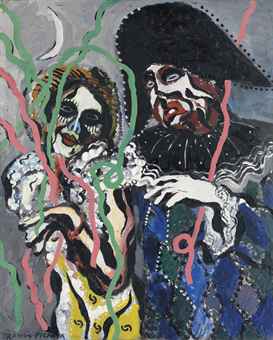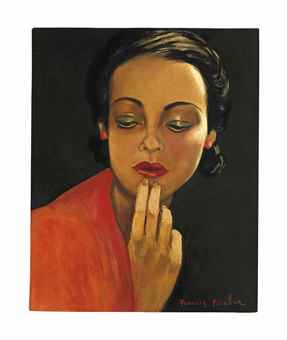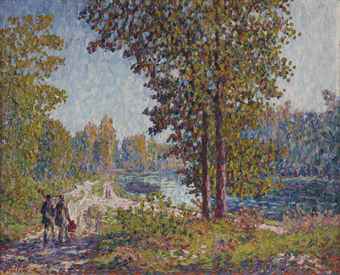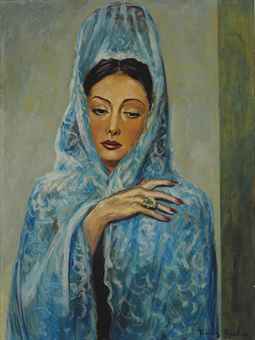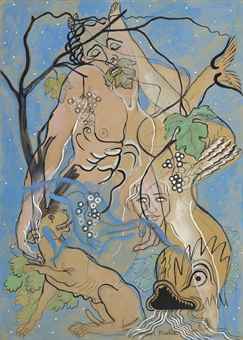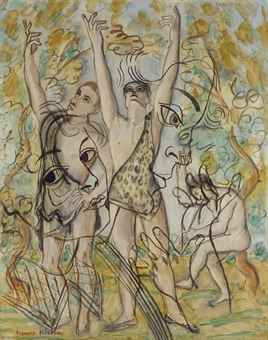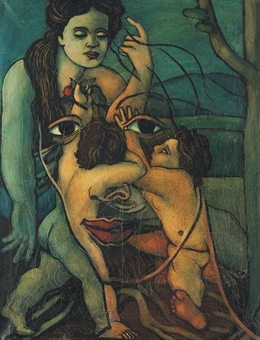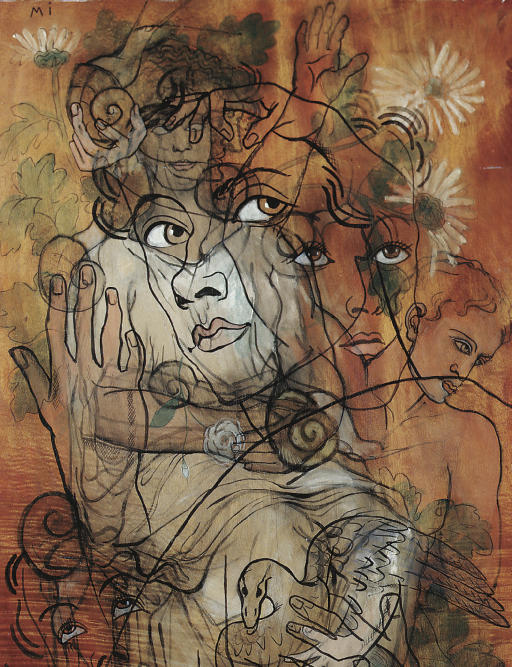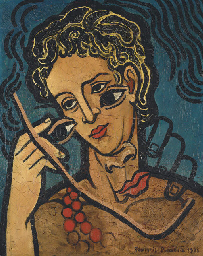
FRANCIS PICABIA
Painted in 1929, Artémis ( estimate: € 500, 000 - 700,000 ) is a remarkable example of the iconic series of Transparences Picabia began i n 1927. These were an immediate success with both collectors and the Surrealist circle. Here, superimposing several motifs and images, the artist draws viewers into a work where different levels of interpretation are discernible . This complex, magisterial work, making its first - ever appearance on the market, immerses us in the very heart of Picabia 's artistic explorations .
Francis Picabia
Ino
watercolour and pencil on paper, in a wood and
coloured mirror frame by Rose Adler
Executed circa 1930
Ino
belongs to Picabia’s elegant Transparences
series, which derives its name from multiple layers of overlapping imagery.
The bold frame for Ino was designed by French fashion, furniture and
jewellery designer Rose Adler, who was given the work directly by the artist –
bringing together Surrealism and Art Deco. In this work, two faces of
undeterminable gender are combined with foliage to create an image of timeless
and contemplative beauty. The deliberately obscure quality renders it a
seemingly impenetrable allegory with characteristics of a dream or mystic vision. The mysterious work is named after the Theban queen Ino, an
example of Picabia’s tendency to choose titles based on Biblical characters and Greco-Roman
mythology. The Transparences also drew their inspiration from Romanesque Frescos, Renaissance
painting and Catalan art – rich in a combination of cultural references that together
become compositions of great beauty and harmony.
Christie's 2017
Magnéto anglaise (1921-22, estimate: £400,000-600,000) is one of a much celebrated series of ironic, ‘abstract’ works that Francis Picabia made for his solo show at the Galerie Dalmau in Barcelona, in November 1922. It was first bought from the artist by the celebrated collector and Parisian fashion designer Jaques Doucet and later formed part of the English collection of E.J. Power for 20 years. Picabia’s ‘mechanomorphic’ abstractions appeared to challenge and lampoon the whole idea of modernist aesthetics, the contemporary art market and the mechanical workings of human sexual attraction and interaction.
Rich in imagery and enigmatic in its meaning, Statices (1929, estimate: £1,300,000-1,800,000) is a captivating example of Picabia’s celebrated Transparency paintings, a series of works named for their depiction of multiple images, layered atop one another in an effect similar to multiple-exposure photography.
Completing this group is Phimparey (circa 1941-42, estimate: £200,000-300,000), a painting that demonstrates a move towards pop art in its reproduction of a popular magazine image.
Francis Picabia Ventilateur (circa1918) Estimate: £1,800,000-2,500,000
An exceptional example of Picabia’s rare and profoundly influential machinist compositions from his Dada period, in this work a ventilation machine is depicted as analogous with a potent female sexuality. The use of mechanical forms and the sensational associations they evoke were fundamental to the artist’s perception of art’s role in the modern, industrialised epoch.
Sotheby’s Surrealist Art Evening Sale 3rd February 2015
Francis Picabia
Lunaris
Oil, brush and ink and black crayon on panel 120 by 94.5cm; 471⁄4 by 371⁄4in.
Painted circa 1929
Est. £800,000 – 1.2 million
Painted circa 1929, Lunaris is an exceptional example of Picabia's celebrated ‘Transparence’ paintings that Picabia executed in the late 1920s and early 1930s. This series of works, which was a marked departure from the artist’s Dadist experiments of the previous decades, derived its name from the multiple layers of overlapping imagery that Picabia employed and is characterised by figurative images underpinned by a Classical beauty.
The first owner of the present work was the influential French art dealer Léonce Rosenberg (1879-1947) who greatly admired Picabia’s work and commissioned several paintings for his home.
As the Museum of Modern Art, New York announced a major Picabia retrospective, scheduled for November 2016, the sale will present two other ‘Transparence’ paintings, including
Lunis, also from circa 1929, (est. £800,000- 1,200,000)
and Espagnole et Agneau de l'Apocalypse, from circa 1927-1928 (est. £160,000-200,000).
Christie’s London 2015: The Art of the Surreal Evening Sale
Mid-Lent (Mi-Carême), painted in 1925, by Francis Picabia is
one of the very few works from the artist’s important ‘Monsters’ series
to remain in private hands (estimate: £1-1.5 million. It has been
requested for inclusion in an exhibition at The Museum of Modern Art,
New York, June 2016 to April 2017. In
the winter of 1924-5 Picabia began a series of paintings that
deliberately ridiculed the rich socialites who celebrated carnival in
Cannes during the winter season. Executed in the cheap brand of
household enamel paint known as Ripolin, these paintings, famously
dubbed by his friend and colleague Marcel Duchamp as the ‘Monsters’,
were based on scenes from the masked balls of Cannes which were
especially decadent and lavish at this time. The present canvas is one
of the finest of this anti-art, anti-modernist and anti-classical series
of paintings that epitomise Picabia’s unique and fiercely
individualistic stance towards both life and art. His deliberately
iconoclastic approach to painting and the carnival-like gaudiness of his
technique were part of a radical and ground-breaking anti-modernist
aesthetic that, though revolutionary and shocking in the 1920s, was to
have a significant influence on many post-modernist approaches to
painting in the 1970s and ‘80s, particularly upon the work of Sigmar
Polke. Similarly, Picabia’s adoption of Ripolin and the free-flowing
liberty this paint lent his work not only influenced Picasso, who used
Ripolin from 1925 through to the end of his life, but can also can be
seen to anticipate Jackson Pollock’s similar free-form use of the medium
in the 1940s.
Christie's 2015
Christie's 2013
Christie's 2015
PRICE REALIZED
$701,000
PRICE REALIZED
€577,500
Christie's 2014
PRICE REALIZED
€373,500
Christie's 2013
PRICE REALIZED
£457,250
PRICE REALIZED
£349,875
Christie's 2012
PRICE REALIZED
£1,833,250
Christie's 2010
£601,250
Christie's 2009
PRICE REALIZED
£385,250
Christie's 2008
PRICE REALIZED
£1,364,500
PRICE REALIZED
Estimate 180,000 — 250,000 USD







